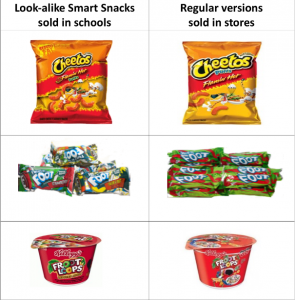Have you had lunch at your child’s school and sat there wondering why kids are still allowed to purchase Doritos and Cheetos, even after the USDA created the Smart Snacks in School guidelines a few years back?
 Well, it turns out that food companies reformulated many of their branded snack foods to meet the Smart Snacks guidelines. The Doritos and Cheetos that children are purchasing in schools are nutritionally better than the ones for sale in the grocery or convenience store, but the packaging is virtually indistinguishable, which is why they’ve been labeled as look-alike smart snacks by food advocates.
Well, it turns out that food companies reformulated many of their branded snack foods to meet the Smart Snacks guidelines. The Doritos and Cheetos that children are purchasing in schools are nutritionally better than the ones for sale in the grocery or convenience store, but the packaging is virtually indistinguishable, which is why they’ve been labeled as look-alike smart snacks by food advocates.
The first-ever study on this topic, released by the UConn Rudd Center for Food Policy and Obesity, found that students and parents are downright confused by this practice.
Here are two key findings from the study:
- Parents and students reported that they had seen four out of five of the look-alike Smart Snacks in stores, even though they are not widely available outside of schools.
- Students believed that they could still purchase the majority of the less-nutritious store versions of these brands in their schools.
It also turns out that the types of snacks sold in schools matter.
Parents and students believed schools that sold look-alike Smart Snacks were less concerned about students’ health and well-being than schools that offered more nutritious snacks.
The good news is that look-alike smart snacks aren’t the only snack products available for sale in schools—Smart Snacks guidelines have greatly improved the availability of nutritious snacks such as fruit, nuts and yogurt products in schools.
Talk with your child about the healthy options available at their school to encourage these choices. If you find that these products are not available, talk with your district’s school food service director about increasing healthy snack options for students.
Sally Mancini is the director of advocacy resources at the UConn Center for Food Policy and Obesity, leading efforts to inform the public, community organizations, advocates and policy makers about the Center’s research related to food marketing to children and its impact on health disparities. Her passion is working closely with parents, youth and other advocates to help develop the resources necessary to support food policy improvements in schools and communities.





